
| Baseball Beat | July 30, 2011 |
There have been a number of articles and interviews published over the past two weeks about my efforts to help Bert Blyleven get elected to the Baseball Hall of Fame. As much for my personal reference as anything else, I am linking to these stories below in chronological order.
"I think the internet helped me a lot. I feel like a guy like Rich Lederer with baseballanalysts.com brought out my numbers. Probably with Zack Greinke and Felix Hernandez winning Cy-Youngs when they didn't have the most wins. Wins are hard to come by. It's hard to win a ballgame. It's easy to lose but it's hard to win."
10. Blyleven and Rich Lederer combined to defy recent trendsAbout 10 years ago, there was a debate at the late, great Rob Neyer Message Board about Blyleven’s Hall of Fame chances. At that time only 15 to 20 percent of the electorate supported him.
To answer the question, I went to my usual modus operandi: I looked at recent historical trends. It showed that of the last 20 guys elected to Cooperstown by the BBWAA (as of then), none had ever received 20 percent or lower of the vote in any election they were up for. None had ever fallen below 30 percent. Or 40 percent. The worst election by any of 20 guys who had gone on to election was one time Tony Perez finished exactly one vote shy of 50 percent.
If you went back further, you could find guys who’d risen up: Billy Williams, Luis Aparicio, Bob Lemon. But that’s the problem, you had to go way back. Many new voters had entered the mix, and old ones passed on. I assumed Blyleven had no chance with the current BBWAA.
But he did. Thanks in no small amount to a campaign led by Rich Lederer to get Bert Blyleven into the Hall of Fame, Blyleven saw his vote total gradually rise up, election after election, until he got in. With the power of the internet, Lederer’s persistence—and, oh yeah, Blyleven’s own solid case—he’ll have a nice weekend in upstate New York this year.
Note that since the Neyer Board discussion ten years ago, things have already shifted. Gary Carter, Rich Gossage, Jim Rice, and Bruce Sutter have all gotten in, after initially finishing under 50 percent. But Gossage and Sutter are relievers, and the Hall is still trying to figure them out. Carter only had one really low year, and it was never as low as Blyleven. Rice benefited from an orchestrated movement by the Boston press corps.
None spent as many years as low on BBWAA ballots as Blyleven. If you’re a fan of sabermetrics, and of internet-based populism, this weekend’s induction ceremony is thus a double victory—one for Blyleven and one for Lederer.
Consider Blyleven. I didn't vote for him for several years before finally seeing the light, thanks in large part to blogger Rich Lederer's insightful writings pleading his case. And eventually, 80 percent of writers agreed with Rich and decided Blyleven belonged in Cooperstown. But we nearly ran out of time before coming to that conclusion. We elected Blyleven in his next-to-last year of eligibility, and Jim Rice in his final year.
The thing about Bert Blyleven's Hall of Fame case was that there was no precedent for leaving out a pitcher of his caliber. It just took baseball writers a long time to figure this out, thanks in no small part to the efforts of blogger Rich Lederer, who tirelessly campaigned for Blyleven's case (click here for Rich's writings on Blyleven).
From Vin Scully's lips to Rich Lederer's computer to Bert Blyleven's plaque in Cooperstown....He heaps plenty of praise for his eventual induction on a campaign over the past eight-some years by Lederer, who created the site BaseballAnalysts.com as a way to re-interpret career data.
Lederer, whose late father George covered the Dodgers for the Long Beach Independent Press-Telegram during the team's first 11 seasons in L.A. and then did public relations for the Angels, started to crunch Blyleven's numbers back in 2003 and built a case that slowly enlightened the Hall voters.
"You look at the new age that we are in with the Facebook and (Twitter) and the online, all that stuff is very important, because I think, as writers that do vote, that is your job to look at numbers," Blyleven said. "And that is what I think Rich Lederer brought out. He brought my numbers out a lot more."
Jon Weisman of the DodgerThoughts.com blog called Lederer's achievement "the most effective grass-roots campaigns for Cooperstown ever." Dave Studenmund, the editor of The Hardball Times, wrote it was "greatest story of Sabermetrics on the Internet."
Lederer, an investment banker in Long Beach who used to deliver the Press-Telegram on his bike, said he wrote about 20 stories about Blyleven. Having it linked and read by other voters were key to getting the word out.
"Such praise from my esteemed peers not only feels good but means I achieved what I set out to do 7 1/2 years ago, which was simply to get Bert Blyleven elected to the Hall of Fame," said Lederer, leaving today with his wife to Cooperstown to join in Blyleven's induction ceremony.
"I have no doubt that my dad would have enjoyed the whole experience, from reading my articles, to watching Blyleven's vote totals increase year-after-year to Bert's election and induction. I only wish Dad were here because I'm quite sure that he would have accompanied me to Cooperstown for this very special day.
"I know one thing. Bert would have received one more vote every year if my dad, who was a member of the BBWAA from 1958 to 1978, were still alive. Just as Bert will be thinking about and thanking his father, who passed away in 2004, I will be thinking about and thanking my dad, too."
2004 – A California blogger, Rich Lederer, starts making a statistical case for Blyleven’s inclusion in the Hall of Fame. Blyleven was named that year on slightly more than one-third of ballots; 75 percent is needed to get into Cooperstown.
What Blyleven didn't know yet was that he had an Angel in his corner. Or a former Angels publicist's son, anyway.Rich Lederer, a Long Beach investment advisor whose father once worked for the Angels, began making a statistics-based case for Blyleven's induction on the blog baseballanalysts.com in 2003. Among other arguments, Lederer noted that Blyleven would have easily eclipsed 300 victories had he received run support that matched the league average.
"I wasn't quite sure what impact it would have," said Lederer, who also lobbied baseball writers over the phone and in person, attending baseball's winter meetings in Anaheim in 2004.
Blyleven soon was a new buzzword among baseball writers, many of whom had previously dismissed his accomplishments as a function of his longevity. His vote total jumped from 17.5% in his first year on the ballot to 79.7% this year, the biggest leap since Duke Snider was elected in 1980 after receiving just 17% of the vote 10 years earlier.
Upon his election in January, in his next-to-last year of eligibility, Blyleven thanked Lederer. He then provided tickets for the induction ceremony — in the Blyleven family section. Lederer will be seated near Blyleven's mother, Jenny, 85, who will make the trip to Cooperstown from Garden Grove.
It will be heavily (and emotionally) SoCal when the baseball Hall of Fame inducts its new honorees this weekend. Former Angels pitcher Bert Blyleven goes in, and that means that Los Angeles blogger Rich Lederer will be on hand. His logical and unceasing case over seven years is the reason Blyleven was elected to the hall, and the pitcher invited the blogger to stand beside him in Cooperstown, N.Y. Forget the "Moneyball" movie, these guys could make a great baseball buddy flick — and they only met this year. Lederer's pre-flight post today:My wife and I are leaving for Cooperstown this morning for the Hall of Fame induction ceremony on Sunday. We will be joined by our son-in-law Joel and my brother Tom and his wife Jeannie this weekend. If not a baseball trip of a lifetime, it should prove to be an unforgettable memory for not only the honoree himself but all of us as well.
There will be a lot of baseball fans and bloggers applauding Lederer along with Blyleven.
I looked. You looked. Bill James looked. Rich Lederer looked. Rich Lederer really looked. We all saw a pitcher who belonged in the Hall of Fame.But for a long, long time the writers -- the writers in the Base Ball Writers Association of America, who vote for Hall of Famers -- just didn't see it that way. The writers have made a great number of mistakes over the years, most of them ultimately rectified. But if you're looking for evidence that the writers have massive blind spots, look no further than their history with Bert Blyleven.
In his first year on the ballot, Blyleven was named on 17 percent of the ballots. In his second year, he dropped to 14 percent. He didn't cross the 50-percent threshold until his ninth try.
Think about that ... For eight years -- and presumably the six years before that, too, when he wasn't yet on the ballot, which makes 14 years -- more than half the (supposed) greatest baseball experts in the world didn't think that Bert Blyleven and his 287 wins, 60 shutouts and his 3,701 strikeouts belonged in the Hall of Fame.
Of course it seems preposterous now, and all the guys who voted for him this time around, all 79.7 percent of them, will probably say it was just a matter of time. But the truth is that if not for Rich Lederer's one-man campaign, Blyleven might still be waiting. Fortunately, Blyleven's mom is still going strong at 85, and she was planning to attend the induction ceremony this weekend. Unfortunately, all those foolish writers who failed for so many years to vote for Blyleven did keep his father from attending; Joe Blyleven died of Parkinson's Disease in 2004.
Being in the Hall of Fame doesn't make Bert Blyleven a better pitcher, all of a sudden. In your mind and mine, Blyleven's exactly the same pitcher tomorrow as yesterday.
But let's not pretend that being in the Hall of Fame doesn't matter. It obviously matters a great deal to him, and presumably to those close to him. That's enough. That's enough for the writers to take their duties as Hall of Fame voters seriously. And while I prefer to think the best of my colleagues, most of whom have been exceptionally kind to me over the years, when I look at what happened to Bert Blyleven for all those years, I detect a frightening lack of seriousness.
For much more about Blyleven and the Hall of Fame, just poke around Baseball Analysts.
His first year on the ballot, 1998, Blyleven received 17.5 percent of the vote. A player needs 75 percent to get into the Hall of Fame, but Blyleven wasn't too worried; he knew he wasn't a first-ballot player. Then in 1999, he dropped to 14.1 percent."It took Harmon four years to get in," he said of Twins icon Harmon Killebrew. "Other pitchers like Don Sutton, guys that I thought my numbers were comparable to, I thought four or five years, maybe the sixth year, is when you'll see that big increase. But it went from like 17 (percent) to 14 to 17 to 19 or 20, and it was just a slow process, and I'm thinking, 'My California math is telling me that in 15 years I'm still going to be at 30 percent. I ain't getting in this thing.' "
After his second-year drop, Blyleven continued a steady rise, except when he fell from 53.5 percent in 2006 to 47.7 percent in 2007. But with a growing appreciation of Blyleven's achievements, thanks in large part to an Internet campaign spurred by Rich Lederer of baseballanalysts.com, his percentages kept climbing. In 2010, he came within five votes of 75 percent. Finally, this year, 79.7 percent of voters put him on their ballots.
"The day we've all been waiting for," said Rich Lederer, a Long Beach, Calif., resident who spent years touting Blyleven's credentials on a website, baseballanalysts.com.
“I was just talking to Peter Gammons (of MLB Network),” Blyleven began. “He told me that he didn’t vote for me and then he asked me to do an interview with him.”Blyleven refused the interview.
For the past 10 years, a fan named Rich Lederer has been conducting an annual campaign to get Blyleven into the Hall, using the same arguments that helped Felix Hernandez win the Cy Young Award last year and Zach Greinke a few years ago with the Royals. As Lederer persisted, and as the analysis of numbers changed, more people were convinced.
“All of a sudden he talks to Rich Lederer and all of a sudden, it’s, ‘Oh my God, he had 60 shutouts, oh my God, he pitched almost 5,000 innings, 287 wins’ and all this other crap, and all of a sudden 14 years later I get in,” Blyleven continued, using Gammons as the example of all that kept him out this long.
The wait was made worse by the fact that Blyleven’s father Joe passed away in 2004 and his mom Jenny is 85, and the trip from the west coast was difficult.
“All of a sudden, it’s hello, do your homework. Maybe the internet stuff will wake up some of the writers that maybe should look at Jim Kaat’s numbers, at Tommy John’s numbers, or guys that maybe should be here that aren’t here. Tony Oliva is another one. Al Oliver, it could go on and on about guys that maybe should be here. I thanked Rich Lederer.”
| Baseball Beat | July 29, 2011 |
I wrote my first of more than 30 articles about Bert Blyleven nearly 91 months ago to the day. I titled it “Only the Lonely: The Hall of Fame Trials and Tribulations of Bert Blyleven.” Only the Lonely was named after the 1960 song by Roy Orbison and was chosen because Blyleven was conspicuously missing from the Hall of Fame while all the pitchers ranked around him in several of the most important stats had already been inducted or were locks to be enshrined in their first year of eligibility.
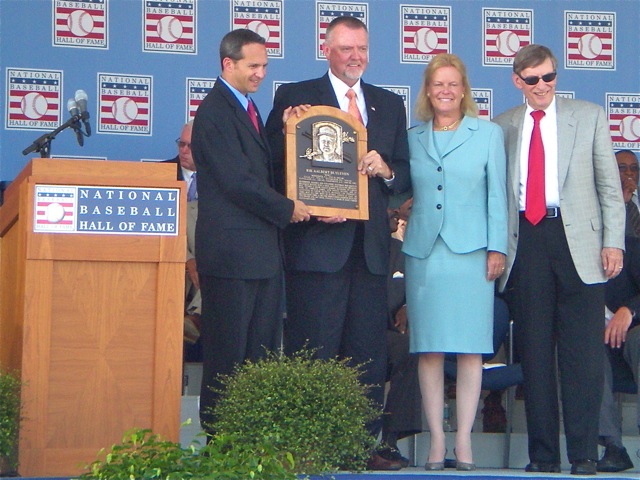 Well, eight election cycles later and nobody can call Blyleven “Only the Lonely” any longer. His vote totals steadily rose from 145 (29%) in 2003 to 463 (80%) in 2011, ultimately piercing the 75 percent threshold needed for election last January. While Blyleven was on the ballot far too long, his date with destiny finally arrived last Sunday when he was officially inducted into the Baseball Hall of Fame. My wife Barbara and I sat in the Blyleven family section during the ceremony as guests of Bert and his wife Gayle.
Well, eight election cycles later and nobody can call Blyleven “Only the Lonely” any longer. His vote totals steadily rose from 145 (29%) in 2003 to 463 (80%) in 2011, ultimately piercing the 75 percent threshold needed for election last January. While Blyleven was on the ballot far too long, his date with destiny finally arrived last Sunday when he was officially inducted into the Baseball Hall of Fame. My wife Barbara and I sat in the Blyleven family section during the ceremony as guests of Bert and his wife Gayle.
I can now say for the first time that the past seven-plus years have been worth every minute. I can also proclaim that the preceding seven-plus months have been joyous and memorable, highlighted by the telephone call I received from Bert informing me that he had been voted into the Hall of Fame 30 minutes before the official announcement was made to the public. He told me that I was his second call, directly after the one to his mother Jenny.
The excitement didn’t stop there though. In fact, it was a fun-tastic two weeks, culminating in a surprise trip to Fort Myers, Florida to meet Bert face-to-face for the first time at a tribute dinner in his honor. After giving each other a big, warm bear hug on stage, I recalled a story about a Saturday afternoon 38 years ago that found me umpiring behind home plate in a winter league scout’s game that the then 22-year-old veteran of four MLB seasons started.
I played catch with Bert and pitched in a fantasy camp game the next morning, followed by a round of golf with him at his club that afternoon. Our foursome tied for first place with a 65 in a scramble tournament. We played well and had a great time on the baseball field and the golf course.
While I may have been the ringleader, getting Blyleven elected to the Hall of Fame was truly a team effort and one that would have never gotten off the ground, if not for the Internet. Darren Viola (known to most of us as Repoz) of the Baseball Think Factory deserves credit for linking to and excerpting my articles, which did wonders for getting the message out in the early going. Alex Belth and Jon Weisman were also prominent linkers. Rob Neyer linked my articles and advocated on behalf of Blyleven. Even Bill James got behind Blyleven's candidacy in The Hardball Times Annual. Jay Jaffe continually endorsed him in his Hall of Fame evaluations at Baseball Prospectus. There were several other backers who chipped in over the years, too.
Importantly, dozens of high-profile writers, including Peter Gammons, Tracy Ringolsby, Ken Rosenthal, and Jim Caple, changed their minds along the way and began to not only vote for Blyleven but helped spread the word and influenced their fellow BBWAA members.
Make no mistake about it, Bert did all the work on the field. Fifth all-time in strikeouts, ninth all-time in shutouts, and top 20 since 1900 in wins. Two World Series championships coupled with a 5-1 record and 2.47 ERA in the postseason only added to his credentials. My job, if you will, was simply to make the voters aware of his accomplishments and qualifications. Lo and behold, Blyleven got his just reward in his 14th (and second-to-last) year on the ballot.
As one of 295 individuals with plaques in the National Baseball Hall of Fame and Museum, Blyleven is no longer "Only the Lonely."
| Baseball Beat | July 27, 2011 |
All of us returned home on Tuesday afternoon. My wife, son-in-law, and I had so much fun that we decided to extend our trip by an extra day. Well, not exactly. We had a lot of fun, and we stayed an extra day. But not by choice.
Instead, our flight out of Albany International Airport on Monday was delayed to the point where we were going to miss the last connection out of Newark, where inclement weather was preventing departures and arrivals for most of the day. If we stayed overnight in Newark, the first available flight to LAX was at something like 5:45 p.m. ET, meaning we wouldn't have returned home until about 9:00 p.m. PT on Tuesday. By staying in Albany, we were able to book a flight at 7:00 a.m. We boarded the plane on schedule but sat on the tarmac for about 45 minutes before returning to the gate for another 45 minutes to refuel and get clearance for takeoff. While we arrived in Philadelphia nearly two hours behind schedule, we walked directly onto our connecting plane and arrived at LAX at roughly 12:45 p.m. PT.
All's well that ends well, especially when one can hold his beautiful granddaughter (the gift of my daughter and son-in-law) once again.
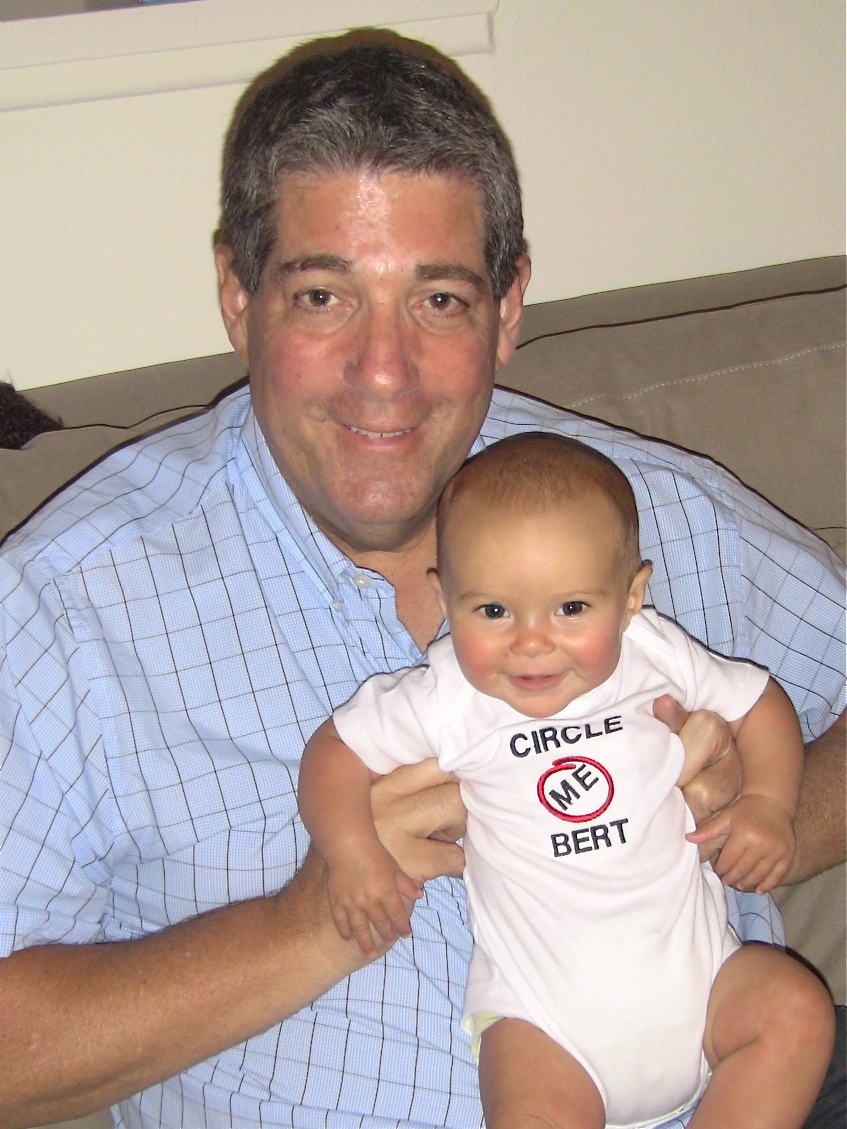
I plan to share more photos and stories of my trip to Cooperstown, including the National Baseball Hall of Fame and Museum, the private reception on Saturday night, and the induction ceremony on Sunday. Check back on Thursday and Friday for additional posts.
| Baseball Beat | July 23, 2011 |
We attended the Hall of Fame Awards Presentation at Doubleday Field from 4:30-5:30 p.m. ET on Saturday. The new event featured Terry Cashman singing Talkin' Baseball (Willie, Mickey, and the Duke), followed by Bill Conlin (J.G. Taylor Spink Award for meritorious contributions to baseball writing), Dave Van Horne (Ford C. Frick Award for broadcasting excellence), and Roland Hemond (Buck O'Neil Lifetime Achievement Award).
Barbara, Joel, and I sat in the stands on the third base side between the pitcher's mound and home plate among guests of the inductees. Jerry Reinsdorf and Dennis Gilbert sat in the row below and just to the right of us. Dave Dombrowski was sitting one row in front of them. There were other front office executives and their family members in the immediate area.
The award winners and Hall of Famers sat on a stage behind second base. Going around the diamond in alphabetical and numerical order by scorekeeper positions, the following players, managers, and executives were on stage: Bert Blyleven (see how I worked that out?), Jim Bunning, Dennis Eckersley, Rollie Fingers, Whitey Ford, Goose Gossage, Ferguson Jenkins, Juan Marichal, Phil Niekro, Gaylord Perry, Tom Seaver, Don Sutton, Johnny Bench, Yogi Berra, Carlton Fisk, Orlando Cepeda, Eddie Murray, Tony Perez, Roberto Alomar, Rod Carew, Bobby Doerr, Bill Mazeroski, Joe Morgan, Ryne Sandberg, Red Schoendienst, Wade Boggs, George Brett, Brooks Robinson, Ozzie Smith, Robin Yount, Lou Brock, Rickey Henderson, Ralph Kiner, Jim Rice, Billy Williams, Andre Dawson, Tony Gwynn, Reggie Jackson, Al Kaline, Frank Robinson, Dave Winfield, Paul Molitor, Whitey Herzog, Tom Lasorda, Earl Weaver, and Pat Gillick.
At the conclusion of the presentations, we were shuttled back to the front steps of the Museum to a VIP viewing area for the Parade of Legends. The Hall of Famers were driven from Doubleday Field down Main Street to the Hall of Fame individually in the back of Ford pickup trucks. We were invited to the Hall of Fame Private Reception inside the Museum afterwards. Hors d'oeuvres and cocktails were served in the Plaque Gallery.
I met Bert and Gayle Blyleven as they walked into the Hall of Fame. Bert and I shook hands and hugged. I introduced both of them to Barbara and Joel. We talked for a few minutes and concluded the conversation with a big, firm high five. I wish I had a photo of that moment but the memory will stay with me forever.
Later that evening, Bert and I met up for a few photos. The first one is of the two of us pointing to the spot on the wall where his plaque will be installed Sunday evening.
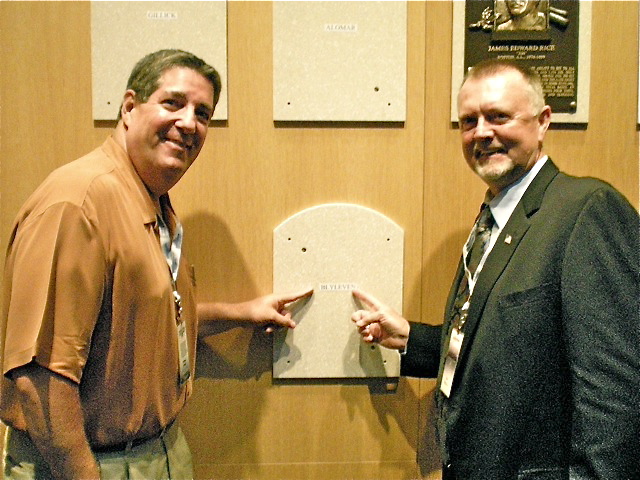
The second is in front of Blyleven's exhibit.
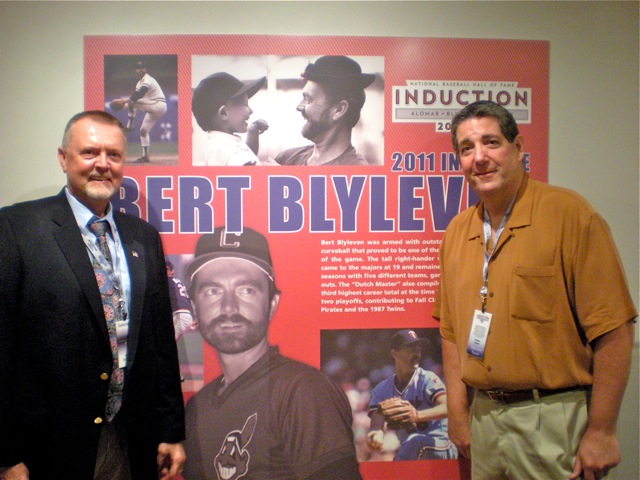
Needless to say, my family and I had a great day, topped by the Hall of Fame Private Reception. Meeting up with Bert in that setting was a once in a lifetime experience.
| Baseball Beat | July 23, 2011 |
I'm posting four photos for now. I will add more later.
My wife Barbara and me standing in front of the National Baseball Hall of Fame and Museum Saturday morning.
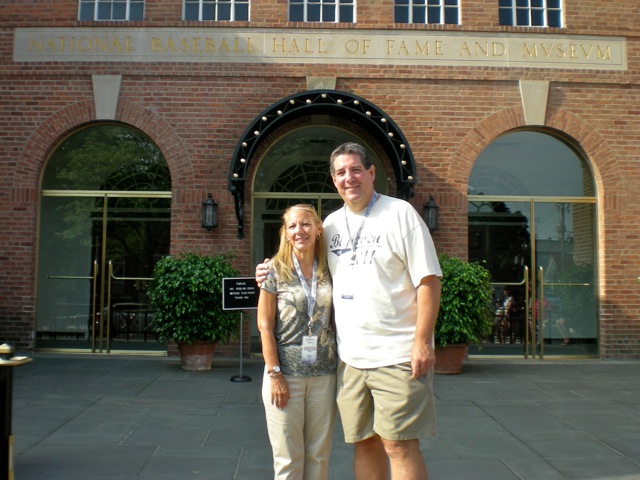
Here I am in the middle with my son-in-law Joel on the left and brother Tom on the right.
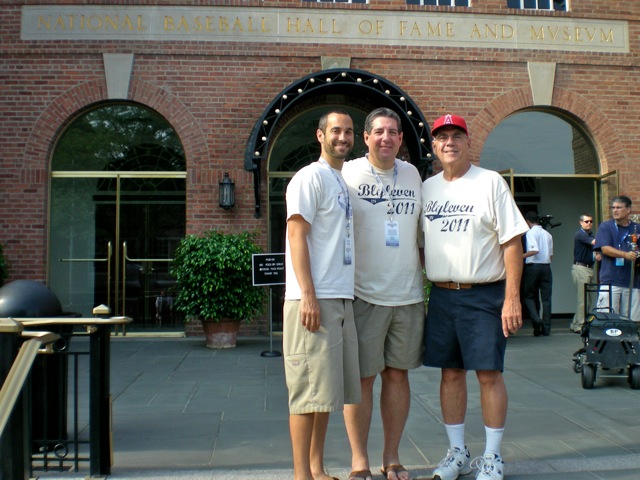
Jeannie, Tom, Barbara, me, and Joel in the Plaque Gallery.
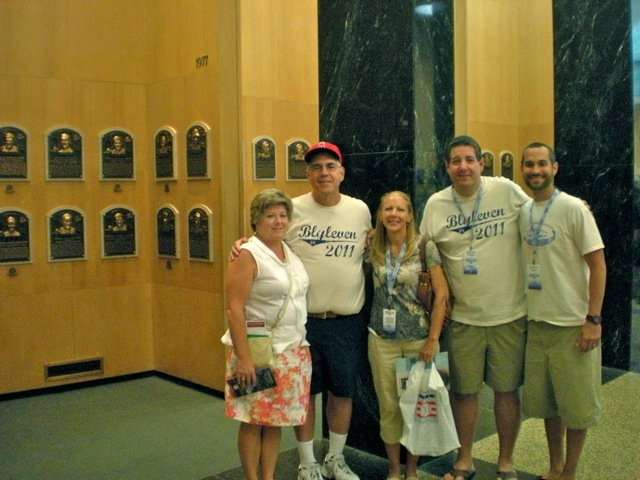
I'm pointing to the spot where Blyleven will be enshrined in the Plaque Gallery forever.

After spending the morning and early afternoon at the Baseball Hall of Fame and Museum, we're now heading to the Awards Presentation at Doubleday Field.
Check back for more photos and stories late this evening or early tomorrow morning.
| Baseball Beat | July 22, 2011 |
My wife and I are leaving for Cooperstown this morning for the Hall of Fame induction ceremony on Sunday. We will be joined by our son-in-law Joel and my brother Tom and his wife Jeannie this weekend. If not a baseball trip of a lifetime, it should prove to be an unforgettable memory for not only the honoree himself but all of us as well.

I plan on posting as many stories, links, and photos as time allows. So be sure to check back throughout the weekend to stay abreast of our trip.
That's all for now.
| Baseball Beat | July 22, 2011 |
The Society for American Baseball Research held its 41st annual convention at the Long Beach Hilton two weeks ago. I enjoyed SABR 41 as an attendee and panelist, as well as for the opportunity to meet many friends in the baseball community.
Scott Boras was the keynote speaker on Thursday morning. You can listen to his 90-minute speech, which focused on his rise from a minor league baseball player to law school to becoming an attorney and then starting his own firm, known today as the Scott Boras Corporation. He talked about the use of both data and psychology in dealing with players, arbitrators, and front office executives, as well as managing the media.
 You can read about and listen to the various panels that took place throughout the convention, including the medical (Dr. Neal ElAttrache, Dr. Kevin Wilk, and Ned Bergert, and moderated by Will Carroll of Sports Illustrated), media (Dave Cameron, Sean Forman, Bill Squadron, and Russ Stanton, and moderated by SABR President Andy McCue), SABR era (John Thorn, John Dewan, Roland Hemond, Wes Parker, and Dennis Gilbert, and moderated by Tom Hufford, one of SABR's 16 founding members), general managers (Jed Hoyer, Fred Claire, and Dan Evans, and moderated by Rob Neyer, the national baseball editor for SB Nation), and player (Tommy Davis and Al Ferrara and moderated by Barry Mednick of SABR's Allan Roth Chapter).
You can read about and listen to the various panels that took place throughout the convention, including the medical (Dr. Neal ElAttrache, Dr. Kevin Wilk, and Ned Bergert, and moderated by Will Carroll of Sports Illustrated), media (Dave Cameron, Sean Forman, Bill Squadron, and Russ Stanton, and moderated by SABR President Andy McCue), SABR era (John Thorn, John Dewan, Roland Hemond, Wes Parker, and Dennis Gilbert, and moderated by Tom Hufford, one of SABR's 16 founding members), general managers (Jed Hoyer, Fred Claire, and Dan Evans, and moderated by Rob Neyer, the national baseball editor for SB Nation), and player (Tommy Davis and Al Ferrara and moderated by Barry Mednick of SABR's Allan Roth Chapter).
During the SABR era panel, Dewan seconded my nomination of Bill James for the Hall of Fame (see excerpt below). At the end of that discussion, I introduced myself to Mr. Hemond, who was the scouting director for the California Angels when my Dad was the Director of Public Relations and Promotions. The longtime executive will be honored in Cooperstown tomorrow as the second recipient of the Buck O'Neil Lifetime Achievement Award. After exiting the room, I stopped and listened to Parker, who was outside entertaining a small crowd of SABR attendees (that's me in the middle and Wes on the far left) with stories about his days as a former ballplayer with the Dodgers. I waited patiently and introduced myself as "Rich Lederer, the son of George Lederer." He had nice things to say about Dad, who covered the Dodgers for Parker's first five years in the big leagues.
I was invited by Cameron to participate in FanGraphs Live in the main ballroom on Thursday night. I served on an Angels/Dodgers panel with Sam Miller of the Orange County Register and Baseball Prospectus, Jon Weisman of ESPN/Dodger Thoughts, and Eric Stephen of True Blue L.A. that was hosted by Jonah Keri, who writes about baseball for ESPN and FanGraphs and stocks for Investor's Business Daily. Keri introduced me as “the first stathead to induct someone into the Hall of Fame.” I also served on a national baseball panel with Cameron (second from the left in the adjoining photo), Vince Gennaro (middle), and Neyer (sitting on the far right) that was hosted by FanGraphs' Carson Cistulli (standing), who entertained us all.
The moderators and members of the audience asked me about the Angels and Dodgers, Bert Blyleven, the Hall of Fame, Jered Weaver, and Bryce Harper, among other topics. Cameron reminded me that I mentioned my disgust about the Vernon Wells signing more than once (or was it three times?). Of note, on the night before the Angels called up Mike Trout, I suggested that the team would have been better off locking him up for ten years rather than giving even more money to Wells for a shorter period. My son Joe, who attended the event along with my son-in-law Joel and brother Tom, informed me bright and early the following morning that the Angels promoted Trout from Double-A to the majors. I went to the Angels-Mariners game that evening and saw the 19-year-old prospect's MLB debut. He went 0-for-3 at the plate but made an outstanding running catch at the warning track in right-center field to record the final out in the top of the ninth inning.
I was interviewed by MLB Network at the convention the following morning. The half-hour segment was videotaped with the possibility of a portion of it being used on This Week in Baseball and/or for a documentary on the evolution of statistical analysis in baseball that will be narrated by Bob Costas and scheduled to air in the fall.
There were also numerous research presentations on Thursday, Friday, and Saturday. I listened to The Joe Morgan Trade by Mark Armour, a former Bob Davids Award winner and the most prolific guest columnist for Baseball Analysts. I had lunch at George's Greek Cafe with Mark and Dan Levitt prior to the former's afternoon presentation. Mark and Dan co-authored Paths to Glory and are working on a sequel.
Bob Keisser, a columnist for the Long Beach Press-Telegram, wrote a preview of the convention and a follow-up that was titled "Baseball Nerdery is Celebrated."
Long Beach native Rich Lederer, whose late father George was a Dodgers beat writer for their first 10 years here, created his own Baseball Analysts website several years ago to write about statistical and historical aspects of the game and provide a vehicle for other writers and links to even more."It's exciting to be here and meet a lot of people I've gotten to know through their work, and to take part in the process," Lederer said.
He got to participate in the main seminar Friday morning about SABR's impact and was feted for his statistical support of Bert Blyleven, the former Angels pitcher who finally was elected into the Hall of Fame.
"They asked me who I would help get into the Hall of Fame next," Lederer said. "I said 'Bill James' and the whole room exploded, clearly behind that idea. Next to Branch Rickey, he's given us the most information to change the way we think about baseball."
Lederer has a second choice, too - Long Beach native Bobby Grich, the former Wilson High star who had a terrific 17-year career with the Orioles and Angels, hit 224 home runs as a second baseman, had a career on-base percentage of .371 and won four Gold Glove awards.
His numbers are comparable with Hall of Fame second baseman Ryne Sandberg (16 years, 282 home runs, nine Gold Glove awards) with the notable exception that Grich, the one year he was on the Hall of Fame ballot, received a mere four votes.
"There were a lot of things back then people didn't consider," Lederer said. "Grich played in two pitchers' parks (Memorial Stadium, Angel Stadium), offense was down in the '70s, and there were a lot of things he did that didn't get people's attention then - that he got on base, was a slugger playing second base, and was the best fielder for most of his career.
"I think he's probably one of the 12 greatest second basemen in baseball history."
Of the 3,000 or so attendees at the SABR Convention here, chances are each fancies their own player like Grich, or an opinion on the horror of pitch counts, or some numbers they've jotted down that you'll never get out of a box score. As gatherings of statistical scientists go, everyone in this group can call themselves a power hitter.
Aaron Gleeman, Jeff Polman, Chris Jaffe, Peter Iorizzo, Cecilia Tan, Geoff Young, Lisa Dillman, Eno Sarris, Sam Miller, Mike Leury posted recaps from SABR 41. You can read excerpts here. The site also links to their full stories, as well as to recaps from local media outlets. You can also read some of the top tweets from SABR 41, too.
I met Gleeman, Jaffe, Young, and Miller for the first time in person even though I have corresponded with the first three via email for years, including going all the way back to 2003 in the case of Aaron and Geoff.
SABR 42 will be held in Minneapolis next summer. In the meantime, if you're not a member of this great baseball organization, you should join now. Annual dues are reasonable and entitle you to many benefits, including discounted fees to the national conventions.
| Baseball Beat | July 21, 2011 |
News: The Tigers designated 3B Brandon Inge for assignment. The 34-year-old Inge "hit" .177/.242/.242 in 239 plate appearances.
Views: How did the two-year contract Inge signed just nine months ago work out for the Tigers?
| Baseball Beat | July 20, 2011 |
Joe Posnanski took a weeklong, cross-country trip that covered five cities and more than 10,000 miles in search of what baseball means in 2011. He traveled from Charlotte to Los Angeles and chatted with Vin Scully, from L.A. to New York to witness Derek Jeter's 3000th hit, from N.Y. to Kansas City to watch a game with Bill James in which Justin Verlander's 100-mph heat was topped by the temperature, from K.C. to Phoenix to catch Prince Fielder "uncoil his wonderfully violent swing" at the All-Star Game, and from Arizona to Cooperstown where a bat stored in the archives "down in the bowels of the Hall of Fame" that stuck with him the most. Yes, Wonderboy, the bat Roy Hobbs made from a tree split in half by lightning in the movie The Natural that reminded both Hobbs and Posnanski of their fathers.
THE BAT stays with me. Isn't that strange? I did so many amazing things on this crazy cross-country trip in search of what baseball means in 2011 ...And so ... why the bat? Why does the bat keep reemerging in my mind, like a summer song that won't stop repeating? It's just a bat. It might not even be regulation size. No one used it to crack his 3,000th hit or smack his 500th homer. This bat was never even used in a major league game, or a minor league game, or a Little League game, or any real game at all.
Still ... Why do I think it's all about that bat?
"Loving Baseball" is Joe at his best. In addition to Scully, Jeter, James, Verlander, Fielder, and Hobbs, Posnanski marvels at the artistry of Adrian Gonzalez's swing, and mentions, in order, Cy Young, Sliding Billy Hamilton, Andre Ethier, Kirk Gibson, Roger Clemens, Willie Mays, Andrew McCutchen, Lance Berkman, Roy Halladay, David Ortiz, Mark McGwire, Barry Bonds, Hank Aaron, Roger Maris, Babe Ruth, Lou Gehrig, Joe DiMaggio, Honus Wagner, Robin Yount, Cal Ripken Jr., Ichiro Suzuki, Sandy Koufax, Walter Johnson, Brayan Pena, Gary Sheffield, Roberto Clemente, Johnny Bench, Ozzie Smith, Greg Maddux, Danny Jackson, Jose Bautista, Pete Rose, Jimmie Foxx, Al Kaline, Tony Gwynn, Harmon Killebrew, Lew Burdette, Ralph Terry, and Bill Mazeroski.
So why is it that as I end this trip, I keep thinking about Wonderboy?...What was I looking for? While in Los Angeles, I heard the awful news about Shannon Stone, a Texas firefighter who brought his son to a Rangers game and fell and died when he lost his balance trying to catch a baseball. In New York, I saw a young man named Christian Lopez grab Derek Jeter's 3,000th hit and then saw his father, Raul, cover him as protection from the crowd. In Arizona, I saw the determined look on Jose Cano's face as he pitched to his son Robinson in the Home Run Derby.
And in Cooperstown, I saw Wonderboy—the bat a boy carved to remind himself of his father. My father worked for most of his life in a sweater factory. When he got home each day—oil on his pants, salami on his breath—we would go to the backyard and play catch. All the while he talked: Get in front of the ball... . Put the glove under your mattress to break it in... . Don't step into the bucket... . Watch how Henry Aaron steps into the ball... . Choke up on the bat with two strikes... . Get back to your feet quickly, like Brooks Robinson... . Remember, it's easier to run in on the ball than to go back.
"They're sending you around to the country to find the meaning of baseball?" he asked.
"Something like that," I said. He looked at me with a mix of disbelief and wonder and, sure, pride. Dad's job was to keep the sweater machines running. It was a clear assignment with a clear mission—plain questions and plain answers and no time for what he always called "baloney."
"Well, baseball is fun, right?" he said.
Baseball is fun indeed.
As the subtitle of the Sports Illustrated article dated July 25, 2011 asks and answers, "What keeps the grand game great? Everything old is new again."
| Past Times | July 13, 2011 |
Those who prefer baseball without steroids and bloated phony physiques might say the current situation means the game is back to normal, but 2011 is shaping up as a season where pitchers often have the upper hand. This midseason (July 12) look at team statistics shows how much the former Home Run Derby approach has changed in the past few years.
Starting with the long ball, 37 players are currently at a 25 HR or higher pace as compared to 53 who reached the quarter century mark in 2009. That's a 30.2 percent decline in a year and a half, and five teams are stumbling along ar a sub-100 HR pace. The offensive slide becomes even more apparent when other stats are examined.
Just one team hit under .250 in 2009, but 10 teams are currently below that level, with the Mariners at a .224 clip that would look right at home in 1911 rather than 2011. That doesn't include the best in the majors (57-34, .626) Phillies, who are listed at .250 which is actually rounded up from .24983 (776 for 3106).
Midseason taildraggers in the batting average numbers features a number of division leaders and contenders for the postseason. The list includes the Pirates (.247), Rays (.245), Giants (.243) and Braves (.237, or 26th out of 30 teams). The Nationals are at .500 (46-46) despite a .235 team average. Currently in last place in the NL West, the 40-52 Padres' .231 total can be partly attributed to Petco Park.
On-base percentages also require some mental adjustments from the recent past. Seven teams are under .310, and that list includes Billy Beane's formerly OBP-conscious A's at .299. Oakland has one of the better pitching staffs in baseball, but a weak-hitting lineup has dragged the franchise down to a 39-53 record and last place in the AL West. The Mariners bring up the rear with a putrid .290 OBP.
The value of OBP, drawing walks and extending at-bats in an era of pitch counts comes shining through when batting averages are on a downward trend. The Yankees are 11th in the majors with a .258 team average, but 343 walks in 88 games (almost 3.9 bases on balls per game) has led to a combined OBP of .340, which ties the Cardinals for second best in the majors.
Despite a 37-55 record, the Cubs are sixth in the majors with a .263 team average, but just 223 walks in 92 games (2.43 per game, or a projected 394 over a full season) has led to an 18th-ranked team OBP of .317. The main offenders in impatience are all hitting over .300. The young double play combo of second baseman Darwin Barney (.306, but just 10 walks in 294 ABs) and shortstop Starlin Castro (.307 with 117 hits and just 16 walks in 381 ABs) are hacking away, as is utilityman Jeff Baker (.306 and four walks in 134 ABs).
The dreadful (30-62 for a major league worst .326 winning percentage) Astros are hitting a respectable .260 (9th in the big leagues), but Houston's meager total of 225 walks drags the OBP down to .312, which is 23rd overall. Third baseman Chris Johnson is the main culprit, with just eight unintentional walks, a pair of intentional passes and 74 strikeouts in 292 ABs. That lack of selectiveness might be forgiven if Johnson was hitting .308 with power as he did in 2010, but a .243, 6 HR, 34 RBI stat line is far from last season's production.
With the exception of Chone Figgins (262 ABs, .183, 1 HR, 14 RBI and a freakishly low .231 OBP), it has been the all or nothing, high strikeout hitters who have suffered the most in the offensive decline of 2011. Adam Dunn (.160 with 117 Ks in 269 ABs for the White Sox) is enduring a historically nightmarish year, but Dan Uggla (340 ABs, .185, 15 HR, 34 RBI), Jack Cust (3 HR, 23 RBI, .211 with 76 Ks and 44 BB in 204 ABs) and Russell Branyan (2 HR, 6 RBI, .196 and 35 Ks in 107 ABs) are also finding the going much rougher this season.
Pitching statistics reflect a return to more balance between offense and run prevention. Compare the 18 starting pitchers with sub-3.00 ERAs to the 11 who ended 2009 at that impressive level. Another 10 starters currently have ERAs from 3.01 to 3.10. Nine staffs entered the All-Star break with sub-3.50 ERA, and the Nationals just missed the cut at 3.53. Just one team - the Dodgers - came through with a staff ERA below 3.50 (3.41) in 2009.
Moundsmen are also more inclined to challenge hitters with a greater variety of deliveries or are adopting a pitch to contact mentality. Nine staffs currently boast a walk ratio below 3.00 per nine innings pitched. Only the Twins and the Cardinals did the same in 2009.
Some would say that prime hitting season is coming up with the high temperatures of July and August, which would mean the first half's numbers are subject to being more favorable to hitters by the end of the season. While that is certainly a logical thought, baseball in 2011 has changed considerably from the slow pitch softball mentality of the earlier part of the 21st century.
| Baseball Beat | July 12, 2011 |
Roy Halladay and Jered Weaver have been named the starting pitchers for tonight's All-Star Game in Arizona, which will be televised by FOX at 8 p.m. ET. While the 34-year-old Halladay has participated in the mid-summer classic in eight of the past 10 years, the 28-year-old Weaver earned his first trip in 2010 but did not play because he pitched on the Sunday preceding the game.
Halladay and Weaver are leading their respective leagues in Fielding Independent Pitching Earned Run Average with FIPs of 2.16 and 2.39. Of note, Weaver also leads Major League Baseball in ERA (1.86), Adjusted Pitching Runs (31), and Adjusted Pitching Wins (3.6). He ranks first in the AL and second in MLB in not only FIP but Fangraphs (4.7) and Baseball-Reference (4.9) Wins Above Replacement among pitchers, ERA+ (199), and Win Probability Added (3.4).
If Weaver is not the best pitcher in baseball, he is certainly one of the top ten, along with Halladay and, in alphabetical order, Cole Hamels, Felix Hernandez, Clayton Kershaw, Cliff Lee, Tim Lincecum, CC Sabathia, and Justin Verlander. A healthy Josh Johnson, Stephen Strasburg, or Adam Wainwright would fill out my list of the best starting pitchers in the game. Cases for inclusion could also be made for Zack Greinke, Tommy Hanson, Dan Haren, Jon Lester, and David Price.
Importantly, Weaver is not a small-sample-size phenomenon. Over the past year, Weaver ranks second in MLB in ERA (2.38), third in FIP (2.59), and 4th in fWAR (7.4). According to Baseball-Reference.com, he ranks sixth among all active pitchers in career ERA (3.32) and ERA+ (128).
It's taken a long time for Weaver to overcome the naysayers in the prospect and stathead community as more than his brother or an innings eater. He is undoubtedly much greater than both. Jered is not only the starting pitcher in the All-Star Game but a leading candidate to win the AL Cy Young Award this year.
Tonight's recognition will do little for Halladay's reputation but should do wonders for the under appreciated Weaver.
| F/X Visualizations | July 08, 2011 |
Last night Bartolo Colon threw a clunker fo the New York Yankees against the Tampa Bay Rays. But, what makes that clunker so amazing is that after twelve starts for the Yankees this was just the third bad start for Colon. After not pitching in 2010 and with just limited success since 2005, Colon's 2011 has been a major surprise. He is striking out 7.9 batters per nine innings, the best since 2001, while maintaining his great command.
Colon is getting the majority of these strikeouts on called strikes. Typically high-strikeout guys get lots of swinging strikes, and Jeff Sullivan showed that swinging-strike rate correlates very well with strikeout rate. But Colon is in the bottom ten among starters at getting swinging strikes, but is solidly above average at getting strikeouts. Jeff Sullivan actually wrote about this strange fact back in May. Colon's strikeouts are coming overwhelmingly on called strikes. He has the highest rate of called strikes (called strikes per pitches) among pitchers with over 500 pitches at 23.7%. The major league average is 17.5%, the next highest is Carlos Marmol with 23.1% and the next starting pitcher is Kyle Lohse with 21.9%.
Colon throws almost all fastballs, 84%. That makes the called strikes that much more interesting. Batters almost surely know that a fastball is coming, but Colon gets takes in the zone anyway. A big part of this comes down to location. Here are the locations of his two- and four-seam fastballs in 2011, with called strikes circled.
To left-handed batters:
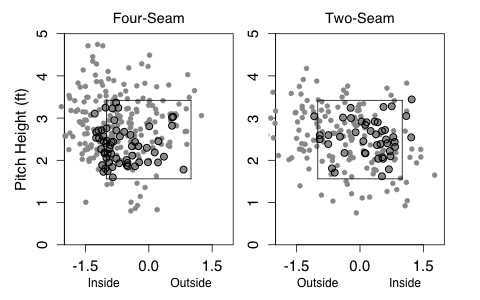
To right-handed batters:
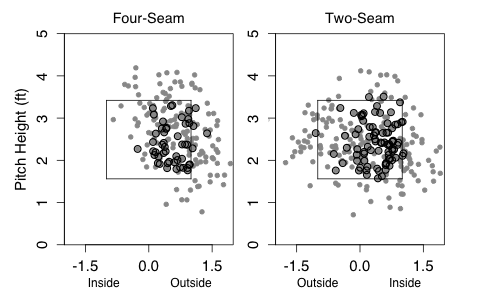
He paints the four-seam fastball on the outer half of the plate, and just piles up called strikes. The two-seam fastball he throws over a wider swath of the plate, but still gets called strikes even over the heart of the plate — most likely from the two-seamer's heavy sink and tail.
Here are three possible — though non-exhaustive and nonexclusive — explanations for his called strikes: (a) Colon hits the corners better than other pitchers; (b) hitters take his pitches in the zone more often than against other pitchers; and (c) umpires call his taken pitches on the edges more often than other pitchers.
Looking at (a):
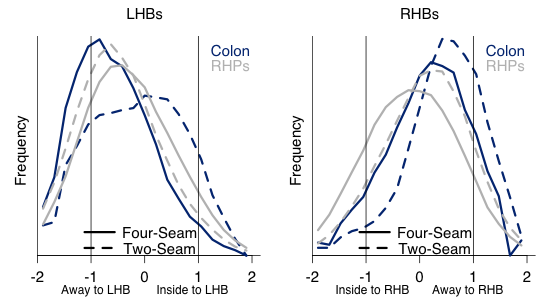
To left-handed batters Colon does throw his four-seam fastball more consistently away than most right-handed pitchers. But his two-seam is throw across the zone, and much more inside than most right-handed pitchers will throw it. Against right-handed batters he goes more consistently away with both his two- and four-seam fastballs than the average pitcher. This already could account for the additional called strikes because these pitches right on the edge of the zone should be more likely to be taken.
Turing to (b), here I just look at pitches that are vertically in the zone (between sz_top and sz_bot):

Against left-handed batters Colon gets considerable more swings away on his two-seamer, but fewer inside. This works well for him as he often throws the two-seam inside to lefties. It looks like they aren't expecting it and often take it. Against right-handed batters he gets swings at about the same rate as average. The swings on his inside four-seamers are probably just noise because he rarely throws inside four-seamers to right-handed batters.
Finally looking at (c), again these are pitches within the zone vertically:
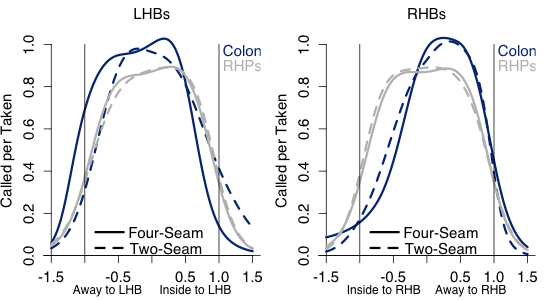
Generally Colon gets more called strikes than average. This could be because he gets the benefit of the doubt since he is always around the zone. Or because his pitches are vertically closer to the center of the zone than the average pitcher's. That is even though I am just looking at pitches between the top and bottom of the zone, Colon's could still be, on average, closer to the heart of the zone. But either way Colon is getting more called strikes on taken pitches.
Overall Colon benefits from all three possible factors: he throws more pitches on the edge of the zone than the average pitcher; his inside two-seam fastball is taken at a very high rate; and his taken pitches are more likely to be called strikes. His last start not withstanding, I am not sure whether he can keep this up. Maybe the league will get on to him and start swinging at his pitches more often. Historically it has been very hard to keep a strikeout rate that high missing so few bats.
| Baseball Beat | July 06, 2011 |
The Society for American Baseball Research is convening in my hometown of Long Beach this week for its 41st annual convention. The event, which takes place at the Long Beach Hilton, kicks off today (July 6) and lasts through Sunday (July 10). The convention marks SABR's first in Southern California since 1993 when it was held in San Diego and the first in the Los Angeles area since 1980.
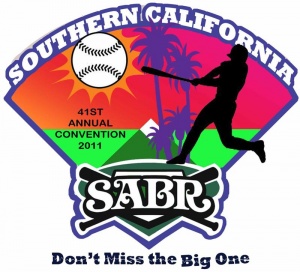 SABR 41 includes five full days of activities and excursions, featuring approximately 30 research presentations, panel discussions, and trips to the Angels and Dodgers games this weekend. The full schedule can be found here. Members and non-members are welcome. On-site registration is $59 for a day, $93 for two days, and $159 for the full conference.
SABR 41 includes five full days of activities and excursions, featuring approximately 30 research presentations, panel discussions, and trips to the Angels and Dodgers games this weekend. The full schedule can be found here. Members and non-members are welcome. On-site registration is $59 for a day, $93 for two days, and $159 for the full conference.
Scott Boras is the keynote speaker at the Annual Business Meeting on Thursday morning. Dennis Gilbert is the featured speaker at the Awards Luncheon on Friday. San Diego Padres general manager Jed Hoyer will join former Dodgers GMs Fred Claire and Dan Evans on Saturday afternoon for a panel discussion ("The Changing Role of the General Manager") moderated by SABR member and SB Nation baseball editor Rob Neyer. Former White Sox and Orioles GM Roland Hemond, a three-time winner of MLB’s Executive of the Year Award and 2011 recipient of the National Baseball Hall of Fame's Buck O'Neil Lifetime Achievement Award, will participate in "The Evolution of Baseball Over SABR's Four Decades" discussion on Friday. Other notable panelists from the sabermetric community include Dave Cameron, John Dewan, Sean Forman, and John Thorn.
I am looking forward to partaking in FanGraphs Live at SABR 41 on Thursday evening. The three-hour event will take place in the main ballroom. It costs $20.
Courtesy of Cameron, the managing editor of FanGraphs, the agenda is as follows:
7 p.m. to 8 p.m. - Dodgers/Angels discussion with Jon Weisman, Eric Stephen, Rich Lederer, and Sam Miller. Jonah Keri will be moderating this panel, and it will likely be split near 50/50 into questions and discussions originated by Jonah and questions from the audience.
8 p.m. to 9 p.m. - National baseball and statistical analysis discussion with Rob Neyer, Vince Gennaro, Rich Lederer, and Dave Cameron. Carson Cistulli will be moderating this panel, and likeways, it will be approximately half questions from Carson and half from the audience.
9 p.m. to 10 p.m. - FanGraphs Q&A with David Appelman, Jonah Keri, Carson Cistulli, Eno Sarris, and Dave Cameron. We'll take questions from the audience with whatever time is left over after the two panels.
Weisman operates Dodger Thoughts and is a writer/editor at Variety. Stephen is an author at True Blue L.A., the Dodgers arm of the of the SB Nation network. Miller is a sports writer for the Orange County Register. Keri writes for FanGraphs and is the author of The Extra 2%. Gennaro is the author of Diamond Dollars and professor at Columbia University. Cistulli is the editor for FanGraphs and host of FanGraphs Audio. Appleman is the president of FanGraphs. Sarris is a writer for FanGraphs, NotGraphs, and RotoGraphs.
I would welcome meeting any attendees before or after the panel discussions or even on one of the subsequent days of the convention. I plan on posting highlights and photos throughout SABR 41.
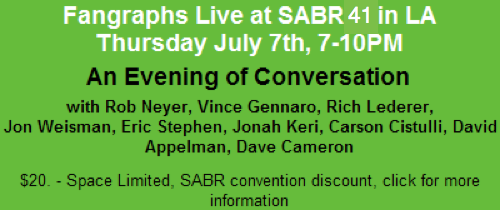
| Baseball Beat | July 02, 2011 |
Thanks to Google Alerts, I was made aware of an interview conducted by David Mark, a senior editor at POLITICO, with Nick Gillespie and Matt Welch, the co-authors of The Declaration of Independents: How Libertarian Politics Can Fix What's Wrong with America in Arena Chat.
My Hall of Fame "campaign" for Bert Blyleven was the subject of part of their conversation. Check out the 10-minute video and accompanying article. If you're pressed for time, fast forward to 3:30 and play it through the 7:00 mark.
Baseball fans, for example, may recall Bert Blyleven, a solid and durable major league pitcher from 1970 to 1992. Hall of Fame baseball writers shunned Blyleven for years, never giving him more than 30 percent of their votes (75 percent are needed for entry to the baseball shrine.)Then a California investment manager, Rich Lederer, took up Blyleven’s cause.
“By penning a series of convincing articles and debating individual voting writers (face-to-face, in many cases), this outside dabbler pulled off the unthinkable: he changed a doomed candidate into a 2011 inductee into the Hall of Fame,” Gillespie and Welch write.
“It shows that you can move around the traditional gatekeepers and centers of power,” Welch said.
Welch, who is the editor-in-chief of Reason magazine, a leading libertarian publication, is perhaps better known around these parts as a diehard Angels fan, astute sabermetrician, and part-time baseball writer. It's hard to believe that his outstanding guest column at Baseball Analysts on Dave Hansen is now more than six years old. Be sure to check out the accompanying photo of Welch singing and Hansen jamming on guitar.
Matt and I grew up on the same block in the Lakewood Village area of Long Beach. While an age difference separated us, our brothers played on the same Little League team, which was coached by Mr. Welch. Unaware that I was the Rich Lederer from his childhood years, Matt linked to my website in 2004, then interviewed me for his inaugural "Infrequently Asked Questions" series in 2005 after discovering that we were not only neighbors but fellow bloggers with a passion for baseball and the Bill James Baseball Abstracts. Most recently, Welch wrote "How a Part-Time Blogger Changed the Face of Baseball's Hall of Fame."
Courtesy of Google Books, here is an excerpt from The Declaration of Independents in a chapter titled "The Democratization of Just About Everything...":
Fred Eckhardt is living proof that the American tradition of impactful pamphleteer activism is more than alive and well. Four decades after publication of the Treatise, it has never been easier for self-publishers and other outsiders to build their own seats at the table and elbow the deadweight aside, forcing the top-down cultures of industrial media (and politics and music and beer and a thousand other sectors) to confront their own banal inadequacies and acknowledge (only after kicking and screaming) the newcomers' contributions. Forget Bill James and pollster Nate Silver—consider the case of Rich Lederer, an investment manager by day and sabermetrics dabbler by night at his Baseball Analysts website.Lederer, beginning in December 2003, spearheaded a one-man campaign to convince the famously stubborn and insular Baseball Writers' Association of America to elect underappreciated 1970s pitching great Bert Blyleven to the Hall of Fame. At the time, Blyleven had never received more than 30 percent of the vote (you need 75 percent to get in). By penning a series of convincing articles and debating individual voting writers (face-to-face, in many cases), this outside dabbler pulled off the unthinkable: He changed a doomed candidate into a 2011 inductee into the Hall of Fame. In a conference call with reporters after his January induction, Blyleven went out of his way to repeatedly thank Lederer, a California investment banker whom he had never met.
Irrespective of your political interests or leanings, I believe you will enjoy The Declaration of Independents. The book is as much about decentralization and democratization taking market share from "the forces of control and centralization" as anything else, and it has applications beyond politics.